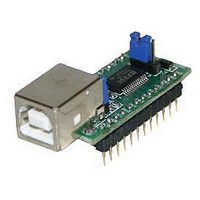UM232R FTDI, UM232R Datasheet - Page 8

UM232R
Manufacturer Part Number
UM232R
Description
Interface Modules & Development Tools USB to Serial UART Dev Mod for FT232R
Manufacturer
FTDI
Type
Development Moduler
Specifications of UM232R
Interface Type
USB, Serial, UART
Data Bus Width
Serial
Operating Supply Voltage
1.8 V to 5.25 V
Product
Interface Modules
Supported Devices
FT232R
Svhc
No SVHC (18-Jun-2010)
Development Tool Type
Development Kit
Kit Features
Single Chip USB To Asynchronous Serial Data Transfer Interface, Auto Transmit Buffer
Rohs Compliant
Yes
Supported Families
FT232RL
Features
Single Chip USB To Asynchronous Serial Data Transfer Interface, Auto Transmit Buffer Control
Tool / Board Applications
USB To
For Use With/related Products
FT232R
Lead Free Status / RoHS Status
Lead free / RoHS Compliant
Table 2 - Jumper J1 Pin Description
Table 3 - Jumper J2 Pin Description
The following options can be configured on the CBUS I/O pins. These options are all configured in the internal
EEPROM using the utility software MPROG, which can be downloaded from the
configuration is described in Section 8.
Table 4 - CBUS Signal Options
UM232R USB-Serial UART Development Module Datasheet Version 1.02
Pin No. Name
1
2
3
Pin No. Name
1
2
CBUS Signal Option Available On CBUS Pin...
TXDEN
PWREN#
TXLED#
RXLED#
TX&RXLED#
SLEEP#
CLK48
CLK24
CLK12
CLK6
CBitBangI/O
BitBangWRn
BitBangRDn
3.3 Jumper Configuration Options
3.4 CBUS Signal Options
3V3
VIO
VCC
USB
VCC
Type
Output
PWR
PWR
Type
PWR
PWR
or
Output
CBUS0, CBUS1, CBUS2, CBUS3, CBUS4
CBUS0, CBUS1, CBUS2, CBUS3, CBUS4
CBUS0, CBUS1, CBUS2, CBUS3, CBUS4
CBUS0, CBUS1, CBUS2, CBUS3, CBUS4
CBUS0, CBUS1, CBUS2, CBUS3, CBUS4
CBUS0, CBUS1, CBUS2, CBUS3, CBUS4
CBUS0, CBUS1, CBUS2, CBUS3, CBUS4
CBUS0, CBUS1, CBUS2, CBUS3, CBUS4
CBUS0, CBUS1, CBUS2, CBUS3, CBUS4
CBUS0, CBUS1, CBUS2, CBUS3, CBUS4
CBUS0, CBUS1, CBUS2, CBUS3
CBUS0, CBUS1, CBUS2, CBUS3
CBUS0, CBUS1, CBUS2, CBUS3
Description
3.3V output from integrated L.D.O. regulator. This pin is decoupled to ground on the module pcb with a 10nF
capacitor. The prime purpose of this pin is to provide the internal 3.3V supply to the USB transceiver cell and
the internal 1.5kΩ pull up resistor on USBDP. Up to 50mA can be drawn from this pin to power external logic if
required. This pin can also be used to supply the FT232RL’s VCCIO pin by connecting this pin to pin 4 (VIO),
or by connecting together pins 1 and 2 on jumper J1.
+1.8V to +5.25V supply to the UART Interface and CBUS I/O pins (1...3, 5, 6, 9...14, 22, 23). In USB bus
powered designs connect to 3V3 to drive out at 3.3V levels (connect jumper J1 pins 1 and 2 together), or
connect to VCC to drive out at 5V CMOS level (connect jumper J1 pins 2 and 3 together). This pin can also be
supplied with an external 1.8V - 2.8V supply in order to drive out at lower levels. It should be noted that in this
case this supply should originate from the same source as the supply to Vcc. This means that in bus powered
designs a regulator which is supplied by the 5V on the USB bus should be used.
VCC Output. This will be 5V from the USB bus if pins 1 and 2 on jumper J2 are connected. Alternativly, if the
module is in a self powered configuration, the supply to the VCC module pins (15 and 21) will be brought out
to this jumper pin.
Connect this jumper J1 pin 2 in order to supply the device IO pins from the supply to VCCIO.
Description
5V Power output USB port. For a low power USB bus powered design, up to 100mA can be sourced from the
5V supply on the USB bus. A maximum of 500mA can be sourced from the USB bus in a high power USB bus
powered design.
Board supply input. Connect to jumper J2 pin 1 in order to supply the board from the USB bus.
This pin is internally connected to the VCC DIP pins. Remove the jumper connector in a self powered design.
Description
Enable transmit data for RS485
Goes low after the device is configured by USB, then high during
USB suspend. Can be used to control power to external logic P-
Channel logic level MOSFET switch. Enable the interface pull-down
option when using the PWREN# pin in this way.
Transmit data LED drive - pulses low when transmitting data via
USB. See FT232R datasheet for more details.
Receive data LED drive - pulses low when receiving data via USB.
See FT232R datasheet for more details.
LED drive - pulses low when transmitting or receiving data via
USB. See FT232R datasheet for more details.
Goes low during USB suspend mode. Typically used to power down
an external TTL to RS232 level converter I.C. in USB to RS232
converter designs.
48MHz Clock output.
24MHz Clock output.
12MHz Clock output.
6MHz Clock output.
CBUS bit bang mode option. Allows up to 4 of the CBUS pins to be
used as general purpose I/O. Configured individually for CBUS0,
CBUS1, CBUS2 and CBUS3 in the internal EEPROM. A separate
application note will describe in more detail how to use CBUS bit
bang mode.
Synchronous and asynchronous bit bang mode WR# strobe Output
Synchronous and asynchronous bit bang mode RD# strobe Output
© Future Technology Devices International Ltd. 2005
FTDI
website. The default
















